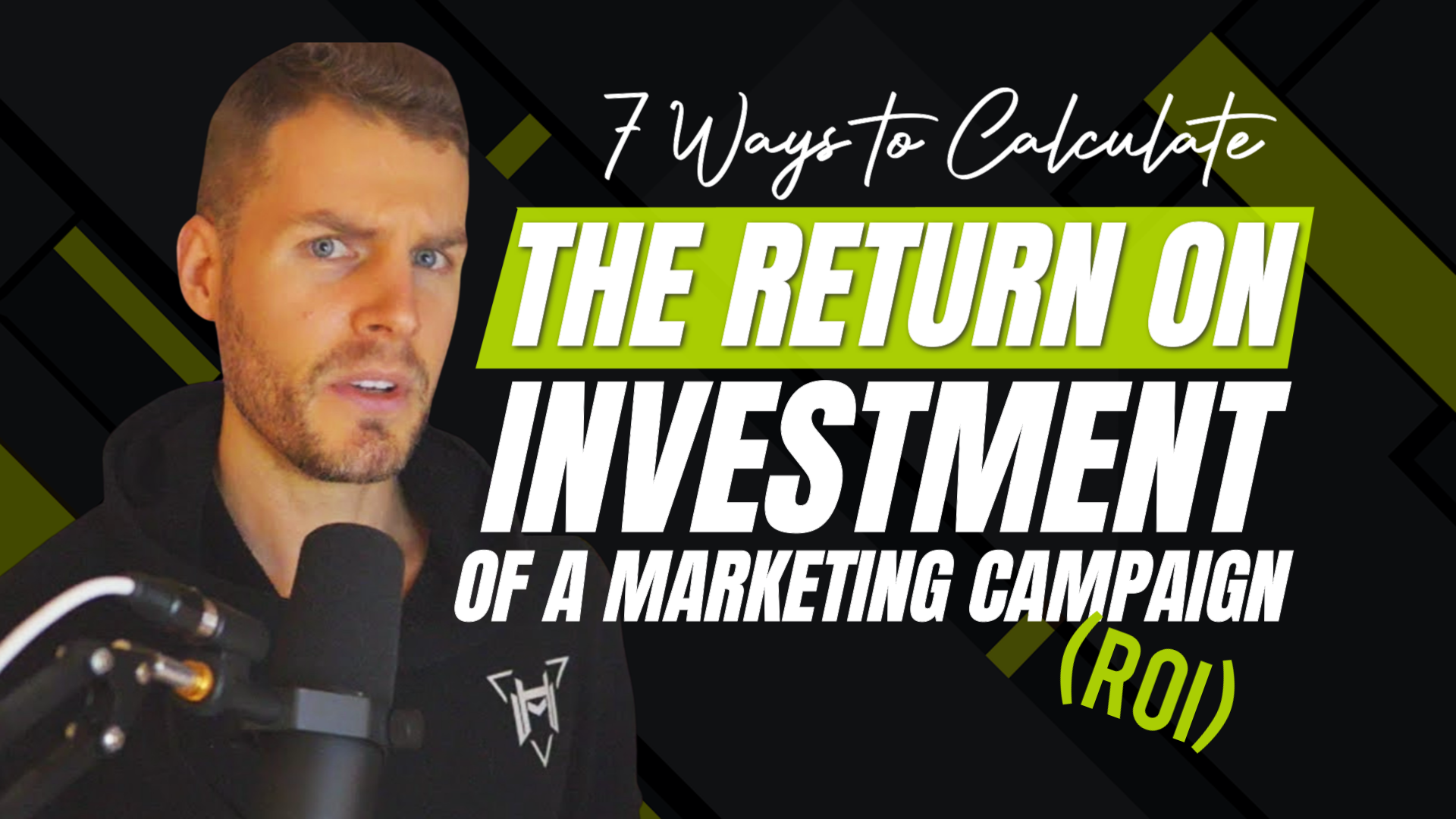
7 Ways to Calculate the Return on Investment (ROI) of a Marketing Campaign
When you put in the work, you want results. It’s how people are wired.
How frustrating is it to put in work and see little to no results?!
If you are one of those people who’ve never had to study, then you may not relate to this. But, if you’re a person who’s ever had to study for a test, you’ll understand.
When you have a major exam coming up, it requires preparation to do well. Whether it’s to get your CPA, become an electrician, or get a passing grade in math, you need to study. In some cases, studying can take quite a bit of time.
You may have spent hours or days on end, pouring over the pages of your notes, study guides, and textbooks. Every spare minute you had, you memorized facts, figures, and formulas. You worked really hard to get a high grade.
The day of the exam arrived and you were so prepared. You were relying on this exam as a stepping stone. You went through each question, feeling pretty confident that you had the correct answers.
You couldn’t wait to get your test score back.
And then you got your score. You did not pass with flying colors. Not even close.
What the heck?!!
You worked so hard and now you have nothing to show for it. That is not okay. You expected serious results for your time spent.
You wanted a major return on your investment. Who in their right mind would invest in something and not want a good return?! This is especially true when you are running a marketing campaign.
A well-run marketing campaign will always require that its performance is tracked and evaluated. If you’re in marketing, then you know that your marketing efforts are meant to directly affect the company’s bottom line in a positive way. When you track your marketing campaign, you want it to show that all the time, effort, and finances have been worth it.
In a marketing campaign, a return on investment is non-negotiable.
What Does Marketing ROI Look Like?
Marketing ROI is pretty simple. In a nutshell, it’s giving credit where credit is due. You have a system in place to measure your marketing efforts, and every vein of the campaign is evaluated. You can justify what you’re spending your marketing budget on when you can show measurable results and how you got them.
It looks like knowing which ads are bringing in new leads and conversions. Once the ROI is calculated, decisions must be made that can have a major impact on your company. So, knowing ways to calculate your return on investment is just smart business.
There are a few things for you to think about first. You want to measure the success of the campaign to get true baselines, assign the marketing budget, justify what you’re spending, and perform a competitive analysis.
Measure the success of your campaign and determine baselines.
This step is a must if you want to create a baseline for measuring future campaigns to compare the two. So, if you haven’t measured ROI correctly in your baseline, all the future measurements will be jacked up!
Assign your marketing budget.
You have a ton of combinations to choose from for your marketing campaign. But none of those combinations are free. Each separate ad will require funding from your budget.
You must justify what you’re spending your marketing budget on.
You have a marketing budget … and every penny must be justified in order to continue getting funds, and most definitely if you want to get even more funding. You have to prove why you need more money and why it is worth it.
Perform a competitive analysis.
You’ve got to check out what your direct competitors are up to. It will help you to figure out how you stack up to the competition and for you to truly know how you’re competing in your race to stand out in your market.
Calculating Your Return On Investment
There are some seemingly simple, basic formulas for calculating ROI.
Here’s one: Marketing ROI = (Value achieved – investment made) / investment made X 100
Here’s another one. You just need to subtract the marketing cost from your sales growth and divide it by the marketing cost.
Boom. You have your marketing ROI. Easy peasy, right?
Yeah … We can’t ignore the fact that this formula is made with the basic assumption that marketing is fully responsible for all of the sales growth. And this means we cannot ignore the unpaid ways that sales come through.
To get the most from your ROI, you need to know exactly how much “return” your marketing efforts have given you.
And then we have this handy dandy formula: ROI = (Total revenue – total COGS – marketing investment) / marketing investment) x100
What the heck is COGS? That’s an easy one. It’s just the “cost of goods sold.”
Now, we need to talk about your gross profit. Knowing your gross profit means that you have a pretty good handle on how much revenue all of your marketing endeavors are bringing you in regard to production costs, shipping, etc.
That being said, we’ve got one more formula for you. The math isn’t complex, people. It’s simply taking your total revenue and subtracting the cost of goods to deliver your product.
Keep in mind that some of what you consider a true return may not be what somebody else considers a return. It truly depends on what you were hoping to achieve or learn through your specific marketing campaign and how you went about running your campaign from start to finish.
So when you’re calculating the ROI of your marketing campaign, you’ll need to consider a couple of things.
Net Profit – If you want to get your hands on your net profit, you’ll need to get a little more into your original ROI calculation. Take your gross profit and subtract any additional expenses, and that gives you your net profit.
Total Campaign Revenue – After you gather all of the numbers to determine your total campaign revenue, you should see a high-level overview of how your efforts paid off. You will more than likely be able to use this number to base future campaign budgets around, plan strategies, or prove the need for more resources.
As you get into the nitty gritty of your true ROI, you want to make sure you’ve turned over every stone, so to speak. In other words, you’ll need to take several costs into account to create an accurate picture of your actual ROI. Be sure to look for these extraneous expenses:
- Creative
- Agency Costs
- Media
- Additional overhead or other internal fees
Alright, so there is one more thing that you need to think about when it comes to your ROI. What does the longevity of your customer relationship look like?! In other words, what is the CLV (customer lifetime value)? When you know the CLV, you know more about brand loyalty and each person’s purchasing power or trend.
You’re kind of figuring out the ROI for individual customers! To calculate CLV, you’ll need to use a more complicated formula. Your customer lifetime value is equal to the retention rate divided by the discount rate divided by the retention rate plus one.
That just sounds confusing. It looks like: (Retention Rate) / (DiscountRate/Retention Rate +1)
What if you want to know how it’s gone for the year? You probably want to know year-over-year growth. The formula looks like this: YOY Growth = (last year’s total – this year’s total) / this year’s total) x 100
How Do You Know If Your Marketing ROI Is Good?
You can expect your ROI to be somewhere around 5 to 1 if it’s decent. When it is fantastic, your ROI will be more like 10 to 1. When you find yourself at two to one, that campaign is not making you any money. So don’t repeat that one!
There is an exception to this rule. When your overhead costs are pretty low, you don’t have to sell as much to get a decent ROI. This is another reason for you to pay attention to all the factors playing a part in each campaign.
Challenges of Calculating ROI
Failure to Consider the Long-Term Game. Marketers tend to be short-sighted when it comes to measuring the success of a campaign. It doesn’t account for the longevity of a customer relationship or customer retention or brand awareness.
Overly-simplistic Marketing Measurements. You need a baseline for sales in order to measure your ROI correctly. To measure accurately, you really need to take the full picture of the circumstances into account. What events were happening? Politics? Season? Weather? Other trends?
So Many Marketing Channels! Many channels mean many touchpoints. This makes it harder to get all of the different measurements and pull them together for really impactful insights. And every touchpoint needs to be taken into account for accurate measurement.
In Conclusion
You don’t want to waste time on ad campaigns that aren’t bringing in more customers and conversions. Ad campaigns should be fruitful in some way that benefits your company.
If you need a really good tool to track your ads, please reach out to me. Hyros is the best company out there for tracking ads. Hyros guarantees that you will see a fifteen to twenty percent improvement, or you aren’t out a dime.
So, call me. I will do a free consultation with you. I’ll look at what you’ve got going on and give you my honest feedback.
That’s it for today.
This has been Alex Becker of Hyros. Thanks so much for your time today. Have a good one.
